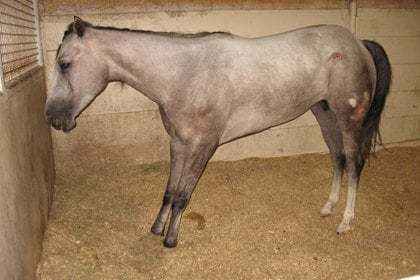
Your Obese Horse or Pony is Costing You Money
Study results suggest caretakers spend nearly $435 more annually managing obese equids compared to their nonobese ones.
Laminitis (commonly called “founder”) affects an estimated 7-14% of the world’s equine population. It’s the inflammation of the tiny, interwoven lamellae that attach a horse’s hoof to the underlying coffin bone (third phalanx, or P3) and support the horse’s entire body weight. Anything that impacts the integrity of the lamellae, such as inflammation, weakens their hold. This causes the coffin bone to displace within the hoof capsule and move toward the ground. The condition is very painful and is often life-threatening to horses.
The same disease has several different causes, which include:

Study results suggest caretakers spend nearly $435 more annually managing obese equids compared to their nonobese ones.

Researchers found a similar prevalence of laminitis in Australian horses and ponies as in America and Europe.

Dr. Lisa Tadros shares information about identifying EMS, PPID, and laminitis in senior horses.
Tweets and take-homes from Friday’s educational sessions on osteoarthritis, tendon injuries, strangles and more.
Two researchers with laminitis-related projects received funding.

Owners did not recognize laminitis in 42 out of 93 cases; rather, they cited undefined lameness, hoof abscess, or colic.

One researcher believes records collected by vets seeing horses in the field could offer new insight into laminitis.

The outer hoof’s health affects the bones and soft tissues within, and vice versa.

Laminitis risk is the No. 1 reason we worry about equine metabolic conditions such as EMS and PPID when feeding horses.

Follow Tess, a 16-year-old mare, step-by-step as she rehabs from a bought of PPID-related laminitis.

Researchers explored if hyperinsulinemia and laminitis severity are correlated in horses recently diagnosed with PPID.

Dr. Andrew van Eps’ lecture will take place May 2 at Penn Vet’s New Bolton Center in Kennett Square, Pennsylvania.

Equine metabolic syndrome can cause obesity, insulin resistance, and laminitis. Find out how to care for your EMS horse during our live event.

In one trial, oral acetaminophen was comparable to flunixin meglumine at relieving hoof pain.

Researching wild and feral horse hooves helps us better understand domestic horse hoof health.

Taking multiple radiographic views–both weight-bearing and not–allows vets to assess the findings most accurately.
Stay on top of the most recent Horse Health news with
"*" indicates required fields